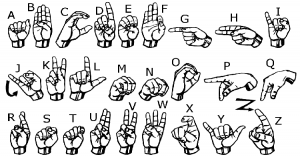If you are in the process of deciding whether to adopt a dog that is deaf, there are a few considerations to keep in mind. In this post, we have broken down everything that you should know about deaf dogs. You can also contact us if you have any other questions you would like answered.
How to tell if your dog is deaf

To find out if your puppy is deaf or hard-of-hearing, there are a few basic at-home tests you can use. These can include making sounds to attract the attention of the dog or rattling your keys close to the dog’s ears to see if they respond. If you think that the dog is struggling to hear, you might want to take your pup to a vet in order to run the official BAER test.
How to train a deaf dog
Similar to any other type of dog, training a dog that is deaf will take a bit of patience and time. There are a few ways that hearing and deaf dogs learn things in a similar way. Consistency, repetition, and reward are the foundations of success. However, there are a couple of important differences:
It is important that you initiate eye-contact with your deaf dog before you will be able to start training them. Even though eye-contact is vital when it comes to training any type of dog, it is even more important when you train a deaf puppy or dog. Because the dog is unable to hear you, making eye-contact is their method of “listening” and responding to you. For this reason it is essential to implement and then reward eye contact that is regular in the earlier stages of training your deaf dog.
“Since dogs share their natural environment with us humans, our emotional vocalisations are likely to be of relevance to them,” says Dr. Keith Maitland, animal chiropractor. “It indicates our close relationship”, but because a deaf dog cannot experience this Dr. Keith Maitland advises, “visual and physical cues are of extreme importance to build the same close relationship”.
A deaf dog relies on cues that are visual. As soon as you have established the attention of the dog, you can then move onto associating different behaviors using hand cues. It is common for many dog owners to make use of different hand signals when it comes to training hearing dogs, but a few words such as “yes” or “no”, is more difficult to represent using your hand. When your deaf puppy responds poorly to a command, or when they respond well, you need to find a way to let them know visually. It is also important to create an appropriate signal for the name you have given your dog.
Training your dog with visual cues can become difficult when the dog is not looking at you directly, for instance when they are a distance away from you, or when they have their back turned to you. You can use a collar that vibrates which will send the dog physical cues as soon as they are not in sight or not looking at you.
The challenges involved with living with a dog that is deaf
 Training a puppy or a dog that is deaf will take a lot of patience, but becomes very similar to training a hearing dog, once you have learned a few different techniques. There are other challenges that come with owning a dog that is deaf in your general day-to-day life.
Training a puppy or a dog that is deaf will take a lot of patience, but becomes very similar to training a hearing dog, once you have learned a few different techniques. There are other challenges that come with owning a dog that is deaf in your general day-to-day life.
For example, a deaf dog is much easier to startle. You need to be mindful that they are unable to hear others or you approaching. It is better to try and practice walking towards them so that they can see you coming. It is also important to encourage your children to not pet the dog from behind. You could also practice stomping your feet as you approach a deaf dog to alert them that you are coming towards them. In order to wake a deaf dog up, touch the dog gently on their shoulder, and avoid touching the dog’s head.
In fact, your deaf dog is capable of teaching you to be more mindful as psychotherapist and mental health expert Wendy Corliss of Living Consciously explains: “Perhaps one of the greatest psychological benefits of interacting with a dog is the opportunity it provides to be more mindful — to purposely focus your attention on the present moment”.
Establish a routine. An easy way to offer any type of dog with security and comfort is to implement a regular daily routine. Walk and feed your dog on a regular schedule, and use these similar cues for meal times or bath time. It is important to try and establish as much stability as possible for your puppy.
Make sure your yard is fenced in, and always make sure your dog is wearing a leash before you walk them. Exercise is important for all types of dog, yet calling a dog that is deaf to return to you, is not possible with these pups. A deaf dog is also not able to sense any hazards such as an oncoming car or wildlife. This is why on-leash walks and a yard that is fenced in is very important to keep your dog safe.
Reasons to think about adopting a dog that is deaf
 Just about any person that has the correct home, love and patience should or can consider the prospect of adopting a dog that is deaf.
Just about any person that has the correct home, love and patience should or can consider the prospect of adopting a dog that is deaf.
The overwhelming mental benefits of dog adoption is explained by Counsellor and Family Therapist Glenn Munt at Thinking Families “The presence of a pet, especially a dog, provides a calming environment and provides a focus that is caring and positive as opposed to negative such as many people with depression experience. Your pet provides unconditional love and acceptance”.
Similar to other types of adoption, the factor that is more important is to determine whether you or the pup have chemistry to develop a lasting and loving bond.
___________________________________________________________________________
Written by: Sarah Springer




